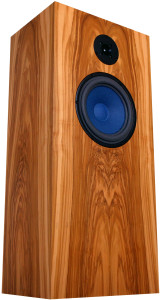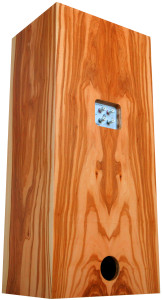I have long been a fan of the AN E series of loudspeakers from Audio Note UK. Having owned the Audio Note K/Spe and as current owner of both the J/Spe since 2003 (reviewed here (https://www.dagogo.com/audio-note-jspe-loudspeaker-review) and the AX two loudspeakers (reviewed here: https://www.dagogo.com/audio-note-uk-ax-two-loudspeaker-review), I now sit in front of the Audio Note E/Lx speakers. I have long felt the Audio Note UK J/Spe was one of the great bargains in the industry for people seeking a non-horn solution for their single ended tube amps. 5-10 watts is enough to get you a rather full scale sound without some of the drawbacks of having to go to very large, high efficiency speakers that often have a habit of shouting music at you. Since becoming a reviewer for Dagogo, I have auditioned many rather spectacular systems, but ultimately I find Audio Note UK loudspeakers, particularly the J and E’s- tough speakers to quit. So, here I am again owning yet another Audio Note UK loudspeaker.
Audio Note UK is one of very few audio companies that offers not only a complete line of audio products from source to speakers, but also distinguishes itself in the sheer array of options within their product lines. Yes, there are companies that offer a couple of amplifiers and a couple of CD players and a couple of speakers and some may even make their own cables and turntables. However, they likely don’t make over 10 versions of the same speaker in 20 different wood options with 2 different finishes on each one. And it is even more unlikely that any of those companies make the majority of their parts in house. This sets Audio Note apart from the rest of the audio industry in that the Audio Note design team has full control of the overall systems that they sell.
The Audio Note UK AN E comes in a dizzying array of options and model numbers, with all but the two most affordable models (the AN-E/D and AN-E/D HEMP) being based on a basic cabinet platform. Full 15-ply, 20mm thick, no void Russian Birch cabinets house their two drivers, while the AN-E/D and AN-E/D HEMP use the same size / volume cabinet, but are made from a different mix of materials, and available in real wood veneer Black Ash only. An example of what I mean by options is that some AN E models come with a choice of either Paper or Hemp woofers and can be bought with regular or high efficiency versions of those woofers, and with regular or AlniCo magnets. (According to Martin Grennall of Audio Note UK, “Regarding magnets; the standard and HE drive units both use ceramic magnets but the HE version is considerably larger. Also, the HE drive unit is equipped with a silver voice coil, and comes with a HEMP cone. The standard efficiency drive units are available with either paper or HEMP cones (as in the AN-E/LX HEMP under review), but have copper voice coils. Expanding on this, the tweeters of the different models are also different; standard and HEMP models use a copper voice coil tweeter, and the HE models use silver voice coil tweeters, to match the voice coils in the corresponding bass drivers.” -Pub.)
Moreover, models with external crossovers contain larger components that cannot be fitted into the AN-E cabinet. In fact, there is so much choice that they can’t keep up with it all on their website which seemingly misses several models of products, so you better ask their dealers.
Under review here is a near-entry level Audio Note UK E loudspeaker called the AN-E/Lexus Hemp. The model below it has the paper woofer and the model above it is the HE (High Efficiency) version offering 97dB sensitivity as measured from room corner position. This speaker is rated at around 94dB sensitivity. While this does not seem like much of a difference to HE models, it certainly matters to 2a3 and 45 SET amp owners or for people listening in larger rooms.
Lexus or LX stands for the particular cabling used inside the loudspeaker. Lexus is the company’s top-of-the-line copper speaker cabling. The next model up has the SPe designation which is their entry level silver speaker cable. And yes, there is a difference and it can be rather significant, as I shall discuss later.
The first thing to impress me opening the boxes and taking them out was the incredible quality of the finish. Even their near-entry level E oozes prestige. With over 40 finishes (probably more if you ask) and high gloss options, you can likely find a finish that will fit your decor. The speakers are not particularly heavy, and not very onerous to position, both desirous properties. The design approach here is instrument-like in which the idea is to control resonances to make them leave the cabinet as fast as possible so as to not store any unwanted energy in the cabinet. The sound is typically quite transparent and nimble through the frequency spectrum. This un-damped box approach impressed me 15 years ago and it still continues to impress.
Setting up the E is straightforward. Placing them on their matched E stands with blu-tak holding the speaker to the stands and placing them in the corners of the room with some adjustments for bass quality is all that is necessary. Audio Note recommends a few hundred hours for break-in but I found them largely excellent straight out of the box. I do recommend you do your best to audition these speakers with solid walls behind them. The speakers use no grill cloths to cover the drivers. (Depending on the room, moving speakers within a space of about 1 foot from the corner may alter bass and tonal response dramatically. Experimentation is encouraged. -Ed.)
Audio Note is in the UK where most structures are made from brick or concrete and not the wood frames and plaster walls of most North American homes or hotels. Rooms with the latter design tend to “sing along” with the speakers, which can be problematic. As I now live in Hong Kong with concrete walls, there is no sing-along from walls or bouncy floors. In a way, you can treat this like a suspended turntable, to which Audio Note subscribes, and in my home in North America the table arm would always bounce if I walked toward it. Not so in Hong Kong and as a result the turntable is rock steady. The speakers here, as a result, have much less overhang or bass boom from floors and walls. The way to counteract this problem if you have sing- along wooden walls is by moving the speakers away from walls and corners, at the expense of bass and sensitivity, and indeed, character. Alternatively, you can counteract room issues by purchasing or building your own corner treatments as you can see in the following video set up by Warren Jarret, an Audio Note dealer in California: https://www.youtube.com/watch?v=s-wyCAYKt74
Audio Note UK builds entire systems and it is desirable, in their view, to use an all-Audio Note system for best results; however, this is difficult for most of us to achieve at the outset so we must use the gear we currently own. I would recommend using Single Ended Tube amplifiers, but the copper wired Lexus speaker is a little more forgiving of lesser equipment than their silver wired speakers. This is another way of saying that they are less resolving and won’t show up as badly the weakness of lesser associated gear.
- (Page 1 of 2)
- Next page →



I heard the Triangle Art, Music First, and Audio Note setup at a recent CAS, and the vast improvement of the Audio Note speakers was stunning, compared to all the other setups I have heard. Whereas previous Audio Note systems failed when they were playing my reference vinyl records, the Music First combination was as good as anything I have ever heard at a dealer or a show. Correction: it was far, far better than anything I have heard, aside from my own system. The sound was liquid, fast, coherent, rich and HUGE. Plus, no annoying “sweet spot” that most speakers have. Here the system loaded the whole room, and the sound was fabulous anywhere in the room. On my fantastic Chet Baker vinyl, the trumpet and Pepper Adams’s sax were in the room! No compression whatsoever. 40 db plus dynamics (from 65 to over 105) . This was using the Audio Note 2a3 amp. Male and female voices were tonally correct with the unlimited dynamics. If you are using an Audio Note system, be sure to get the backing they were using here. I am sure Music First can provide them. This was the E version that cost about $15,000. Be sure to use analogue for this quality of sound.
I own both the original Snell E’s and J’s made by Peter Snell in Newbury Port, Mass. These are the forbearers of the current Audio Note speakers. They do indeed sound quite wonderful! As I expect the UK versions by AN do, albeit at rather higher cost! But mine were made 25+ years ago when costs and prices were considerably lower! The E’s and J’s show that older classic designs can still be competitive with today’s speakers (with some upgrading of crossover parts)! AN UK licensed the design from Peter Snell before his untimely death at a relatively young age (on his factory floor!). Very sad for the audio world to lose such a talent! His original Type A’s, C’s, E’s, J’s and K’s are very desirable and collectible!
Why dope the speakers when you can dope the listener.